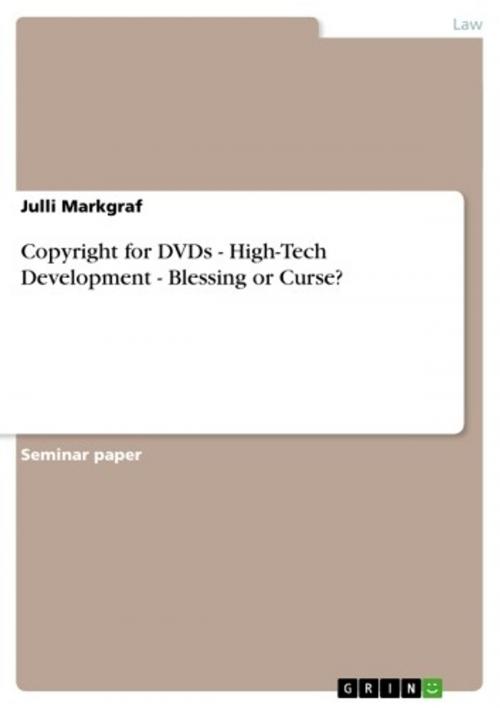Copyright for DVDs - High-Tech Development - Blessing or Curse?
High-Tech Development - Blessing or Curse?
Nonfiction, Reference & Language, Law, Media & the Law| Author: | Julli Markgraf | ISBN: | 9783638258227 |
| Publisher: | GRIN Publishing | Publication: | March 2, 2004 |
| Imprint: | GRIN Publishing | Language: | English |
| Author: | Julli Markgraf |
| ISBN: | 9783638258227 |
| Publisher: | GRIN Publishing |
| Publication: | March 2, 2004 |
| Imprint: | GRIN Publishing |
| Language: | English |
Seminar paper from the year 2003 in the subject Law - Media, Multimedia Law, Copyright, grade: 62 %, Bond University Australia (Law School), course: Intellectual Property, 23 entries in the bibliography, language: English, abstract: Following up the last mentioned development, the copyright of DVD's and the protective sanctions, which the copyright owners of the film industry imposed, will be the central focus of the assignment. However, the paper will not address the issue of downloading film data from the Internet. For the purpose of that paper, the question of backing up purchased DVD's will be the major focus. Under the Copyright Act 1968 (Cth), film is defined under secondary work. In order to distinguish works from secondary works, the Copyright Act 1968 defines 'protection of forms of expression that are artistic, literary, dramatic and musical items'4 as works, whereas mechanical rights, 'such as films, sound recordings, television broadcasts and published editions'5 are defined as secondary work. The reason for that differentiation is that secondary work is generally based on a work. However, the copyrights exist independent of each other simultaneously.6 Furthermore, 'film is defined as the aggregate of visual images capable of being shown as a moving picture, including the soundtrack.'7 This also includes movies which are made by computer animation, such as Finding Nemo for example. Moreover, even interactive video games fall under the definition of film since the decision of Saga Enterprises LTD v Galaxy Electronics Pty Ltd (1997) 147 ALR 2. However, the paper will not deal with cinematographic films defined under that case (interactive games) but will only focus on movies in a classical understanding. As previously mentioned, the film industry developed several protective strategies, which were supposed to resist against copyright piracy. However, the copyright owners had to face several bitter discomfitures. A 15-year-old Norwegian used basic mathematic formulas and cracked the protective code. New high-tech technology offers devices for easy DVD copying of already purchased products. The segmentation of the market in several area codes is facing the test of the infringement of competition law. Also subject to the question of competition law was the question dealt with in the Australian case Australian Video Retailers Association Ltd v Warner Home Video Pty Ltd [2001] FCA 1719, where Australian Video Retailers refused to accept the Warners approach of introducing two different DVD types on the market, one for retail and one for rental.[...] 4 Quirk, P., Forder, J., Electronic Commerce and The Law, p. 181. 5 s. above, p. 181. 6 s. above, p. 181. 7 s. above, p. 187.
Seminar paper from the year 2003 in the subject Law - Media, Multimedia Law, Copyright, grade: 62 %, Bond University Australia (Law School), course: Intellectual Property, 23 entries in the bibliography, language: English, abstract: Following up the last mentioned development, the copyright of DVD's and the protective sanctions, which the copyright owners of the film industry imposed, will be the central focus of the assignment. However, the paper will not address the issue of downloading film data from the Internet. For the purpose of that paper, the question of backing up purchased DVD's will be the major focus. Under the Copyright Act 1968 (Cth), film is defined under secondary work. In order to distinguish works from secondary works, the Copyright Act 1968 defines 'protection of forms of expression that are artistic, literary, dramatic and musical items'4 as works, whereas mechanical rights, 'such as films, sound recordings, television broadcasts and published editions'5 are defined as secondary work. The reason for that differentiation is that secondary work is generally based on a work. However, the copyrights exist independent of each other simultaneously.6 Furthermore, 'film is defined as the aggregate of visual images capable of being shown as a moving picture, including the soundtrack.'7 This also includes movies which are made by computer animation, such as Finding Nemo for example. Moreover, even interactive video games fall under the definition of film since the decision of Saga Enterprises LTD v Galaxy Electronics Pty Ltd (1997) 147 ALR 2. However, the paper will not deal with cinematographic films defined under that case (interactive games) but will only focus on movies in a classical understanding. As previously mentioned, the film industry developed several protective strategies, which were supposed to resist against copyright piracy. However, the copyright owners had to face several bitter discomfitures. A 15-year-old Norwegian used basic mathematic formulas and cracked the protective code. New high-tech technology offers devices for easy DVD copying of already purchased products. The segmentation of the market in several area codes is facing the test of the infringement of competition law. Also subject to the question of competition law was the question dealt with in the Australian case Australian Video Retailers Association Ltd v Warner Home Video Pty Ltd [2001] FCA 1719, where Australian Video Retailers refused to accept the Warners approach of introducing two different DVD types on the market, one for retail and one for rental.[...] 4 Quirk, P., Forder, J., Electronic Commerce and The Law, p. 181. 5 s. above, p. 181. 6 s. above, p. 181. 7 s. above, p. 187.















